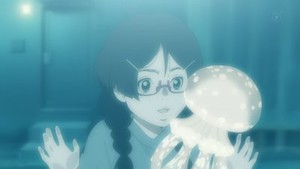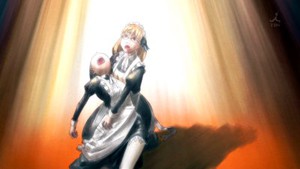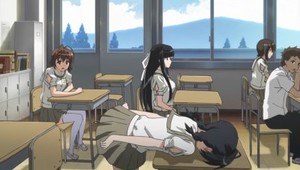The Fall 2010 Anime Preview Guide
Carlo Santos
by Carlo Santos,
Born in a third-world dictatorship and raised in a cutthroat capitalist city-state, Carlo (which is spelled WITHOUT an "s" thankyouverymuch) came upon the world of anime after being introduced to some dangerous friends and their dangerous hobbies. Ten years later he has sunk thousands of dollars into DVDs he never watches, manga volumes he never reads, and a CLAMP-themed chess set he never plays. But he still can't believe Bleach hasn't been canceled yet, so he continues to watch that every week. During late nights he also likes to cuddle up and make music with his sweetheart of almost two years, an electric violin named Aya.

Kuragehime
Rating: 4.5 (of 5)
Review:
The best is saved for last this season as the ol' reliable Noitamina block turns in its Fall offering. Kuragehime (which, in manga form, is highly recommended by living legend Moto Hagio) tells the tale of Tsukimi Kurashita, an 18-year-old who dreams of becoming an illustrator. However, Tsukimi's most fascinating trait is that she is a fujoshi—a nerdy, eccentric "rotten girl" obsessed with jellyfish. The Tokyo boarding-house where Tsukimi lives is shared by other like-minded eccentrics, including a train freak, a Three Kingdoms history buff, an antique doll collector, and others. So begins a slice-of-life comedy that reveals a criminally overlooked part of the fandom—I mean, how many anime series can you name about geeky boys living out their geeky-boy dreams? And then how many Kuragehime-like series can you name? Exactly.
Tsukimi's bizarre adventures take off when she stops by the neighborhood pet shop to observe the jellyfish tank, then discovers that her favorite specimen (which she has unofficially nicknamed Kurara) is in danger because of an incompatible species inside the tank. Desperate to save Kurara, Tsukimi unsuccessfully tries talk the store clerk—a cool and fashionable young man, and therefore anathema to fujoshi—into letting the creature out. Luckily, a cool and fashionable "princess" comes to Tsukimi's rescue ... but an unpleasant surprise awaits the two of them when they bring Kurara home. For viewers, however, this pilot episode is loaded with pleasant surprises, with its witty commentary on nerd culture versus Shibuya ("hipster") culture, abnormal yet endearing characters, and its lively, polished visual style. The animation may not exactly be a 60-frame-per-second technical showcase, but it nails the key frames and gestures beautifully—what else would one expect from studio Brain's Base, of Kamichu and Kure-nai fame?—along with distinctive character designs that gleefully defy traditional anime standards of beauty.
A charming if subdued soundtrack sets the musical tone for this show, but it's the opening—set to a zany sequence of movie parodies—that'll really make fans take notice. With that kind of creative spark setting things off, the rest is going to be a surefire hit.

Tantei Opera Milky Holmes
Rating: 0 (of 5)
Review:
Goodness gracious, what time machine did they pull this one out of?
In the anime world, there are high-budget productions, there are low-budget productions, and then there are productions where they must have taken away the staff's drawing boards and computers and replaced them with stones and twigs. Tantei Opera Milky Holmes, which ties in to a PSP game and collectible card game, should have been best left as a gaming product—since there was apparently no money left to make a decent anime. Hastily colored backgrounds, poorly drawn props, cheap animation shortcuts, and character designs straight out of the 90's make quick work of burning everyone's eyes out before the opening sequence is even finished.
Meanwhile, those who survive long enough to watch the actual episode can look forward to brain damage as a complement to their burned-out eyes. The plot centers around a color-coded quartet of schoolgirls known collectively as Milky Holmes, who use their psychic powers (known as "Toys" in this universe, because apparently creators are running out of goofy nicknames for psychic powers) to solve crimes and stop a band of "Gentlemen Thieves." However, when they lose their Toy powers several minutes into the episode, the girls also lose their motivation and start screwing around at the Holmes Detective Academy, where entire generations of schoolchildren can study to be super-sleuths. By the way, if the idea of majoring in Forensic Science before you're even in high school doesn't sound loony enough, consider that the villainous Thieves are all covertly posing as staff and students at the school. If Milky Holmes are so smart, why haven't they figured that out? By the episode's end, the girls are given an ultimatum: get your Toys back in three months or be expelled. This comes as no surprise.
In summation, the episode consists of about 20% premise and setup, 80% random schoolgirl antics, and 0% actual crime solving. Right now, Sir Arthur Conan Doyle isn't rolling in his grave. He's crawling out of it and ambling across the Eurasian landmass so he can strangle the necks of the people who made this.
Tantei Opera Milky Holmes is available streaming on Crunchyroll.

Soredemo Machi wa Mawatteiru
Rating: 4.5 (of 5)
Review:
In a season where screwball comedy is king (Panty and Stocking, Arakawa Under the Bridge, Squid Girl), this series might just narrowly edge them out as the emperor. It's practically impossible to find any weaknesses in Soredemo Machi wa Mawatteiru, which positions itself as a Swiss army knife of upbeat humor. If the satire on maid café culture doesn't get you, the endearing main character will. If the main character doesn't get you, the slapstick gags will. If the slapstick doesn't get you, the top-notch animation—daring camerawork, expressive gestures, stylistic shifts, and spot-on comic timing—most certainly will.
Beneath this multifaceted hilarity, though, lies a fairly simple plot: Hotori Arashiyama is your average klutzy schoolgirl working part-time at a local café, run by an aging proprietor known simply as "Granny." Although the café has some classy touches with its hardwood furniture and the staff (all two of them) wearing English-style maid outfits, it's far more subdued than the typical all-singing all-dancing maid cafés of Akihabara ... until one of Hotori's classmates stops by and decides that they need to do a better job of welcoming home one's master. And so it goes.
The secret of a great ensemble comedy, of course, is having instantly likable characters—and every single one here so far is a bona fide hit. Hotori, despite her fairly standard archetype, totally owns the role with her stupid-funny utterances and ballet-like pratfalls (even if the animators seem a bit too much in love with super slow-motion). The exchanges with other characters in the show also sparkle with comedic brilliance, whether it's Hotori's pal Tatsuno waxing rhetorical on the essentials of maid culture or her gruff homeroom teacher lecturing her on proper service when he stops by as an unintentional customer.
Even the opening and ending sequences come alive with humorous energy (somehow, Hotori rocking out on accordion just makes sense), and the subtle jazz soundtrack carries each scene with a lively rhythmic bounce. Clearly, SoreMachi is one of those miracles where everything comes together, and those who would miss out on it do so at their own risk.

Squid Girl
Rating: 4 (of 5)
Review:
As soon as the hyperactive, 180-beat-per-minute theme song starts up, you know what you're getting into with Squid Girl. This bright, vivacious comedy is one of the gems of the season, free of fanboy fetishes and genre restraints and instead committed to just one thing: being as crazy—and funny—as possible.
And guess what? It succeeds. Episode 1 introduces the premise in about half a minute: a vengeful squid, sick of human pollution, takes on the form of a human girl and intrudes upon a seaside café where she vows to conquer humankind. But her planned invasion gets sidetracked when the café's no-nonsense proprietors mistake her for a part-time job seeker and inundate her with waitress duties. It's so simple, but so open to comedic possibilities, plus the tight format of three segments per episode forces those gags to come flying at light speed. In just under 25 minutes we learn of Squid Girl's miraculous tentacular hair, her inability to tell between regular humans and regular humans dressed up as squid, and her habit of coughing up ink (a hilarious effect that is used to its maximum potential). But it's not just her sprightly character and delusions of grandeur that make the show; the café's staff (sisters Eiko and Chizuru) and their little brother also cause sparks of humor to fly whenever they get into an exchange with their new oceanic friend.
The animation may not win any awards, but there's definitely enough production polish for it to be enjoyable, especially in slapstick action scenes where the framerate jumps up and the tentacles start flying. The character designs, too, show that it doesn't take a lot of detail and technique to create a memorable cast—start saving up now for Squid Girl figurines now, folks, because something that iconic and adorable comes maybe once every few seasons. With lively, expressive gestures and a nice helping of visual gags to top it off, the show carries itself as a classic gag comedy without feeling forced or running out of budget partway through. She may never succeed at invading the planet, but Squid Girl has already invaded everyone's hearts
Squid Girl is available streaming on Crunchyroll.

Sora no Otoshimono Forte (Episode 2)
Rating: 2.5 (of 5)
Review:
Sora no Otoshimono Forte wants to be serious. Really, it's trying! Sugita is painstakingly researching the imagery behind Tomoki's dreams, and the newly arrived Angeloid makes all sorts of ominous pronouncements when her brain gets fried and she starts babbling cryptic information—oh, who are we trying to kid. This series is two episodes in and all it cares about right now is making as many raunchy locker-room jokes as possible. In that respect, it succeeds. But whether it succeeds as an anime worth watching is something else entirely.
The comedic motivation behind this episode is simple: hapless hero Tomoki, sick of feeling a sudden tightness in his pants every time he's surrounded by the lovely angel-cyborg-something duo of Ikaros and Nymph, runs off to a Buddhist monastery to harness his bodily desires. Cue dozens of adolescent gags about erections, compounded by the fact that a new winged beauty—Astrea—has fallen almost literally into Tomoki's lap. Astrea has been assigned to kill Tomoki, although with her painfully low intelligence this turns out much harder than planned. After a particularly drawn-out segment where Tomoki tries to rid himself of his naughty magazines (accompanied by slapstick violence on the part of Ikaros and Nymph), things officially go way beyond the loony bin with the "Enlightenment Sequence" where Tomoki discovers the secrets of the universe ... from beneath Astrea's skirt.
And later his naughty magazines magically come to life.
For all its crassness, the sexual immaturity, the complete abandonment of plot for the sake of a few cheap laughs, Sora no Otoshimono Forte does have a way with surreal, off-the-wall humor. The last several minutes are a tour de force of the imagination, albeit a very warped one (including the ending, which is almost up there with the "Flying Panties" one). Fortunately there's enough animation budget and talent to pull off this madness—the series continues to deliver plenty of visual variety, with energy to spare. It's just a shame that most of that energy is spent on boob jiggle. Clearly this show is very much an acquired taste—or lack of taste, as the case may be.

To Aru Majutsu no Index II
Rating: 2.5 (of 5)
Review:
Although the world of Index is best known for its large cast of characters and their myriad mystical powers, the premiere episode of the new series makes a surprising move by debuting with as few characters as possible. Fans of the action-packed supernatural-sci-fi hybrid will be reacquainted with Touma Kamijou, he of the power-canceling right hand, and his pint-sized, religiously garbed companion Index. That's all that's needed to power this episode, in which a Crazy Blind Guy with a forearm-mounted crossbow tries to kidnap Index while ruining Touma's last day of summer vacation in the process. It turns out that Crazy Blind Guy wants to access the enchanted library of spellbooks stored inside Index's head, but his attempt to extract the book falls apart in a cacophony of magic, explosions and buckets of blood. Then Touma reminds everyone how useful his "useless" right hand is by stopping the cacophony and saving the day.
As an action series with a thick layer of sorcery on top, this opening episode does just enough to get by, but little more. Premise, conflict, resolution: they teach you that as an exercise in screenwriting class. There is, of course, enough energy and flair to drive the plot forward—the crossbow-induced collateral damage, the dramatic rooftop confrontation—but that's what one expects from Index, and simply meeting expectations isn't going to add new fans to those already lined up and sat down just because they liked the first series. The occasional comedic asides are a nice touch, like the bickering between Touma and Index and the quiet whimsy of their pet kitten Sphinx, but again, it's just a replay of the same stuff that happened last time. The animation technique shows plenty of confidence in using tricky angles and close-ups to add punch to the action scenes, and the electronic soundtrack on top of that creates a genuine air of urgency. But in a world where the spiritual/superpowered warfare thing is beyond played out (with the Index franchise being a major contributor to that), it's just hard to feel the same excitement anymore.

Fortune Arterial
Rating: 0 (of 5)
Review:
The wistful plucking of an acoustic guitar ballad ...
A nondescript boy riding on a train ...
The brick walls and greenery of a parochial boarding school emerging in the distance ...
Hey, haven't I written this review somewhere before?
If there is a special of level of Hell for anime adaptations of ero-games, Fortune Arterial wouldn't even be allowed in. No, it would have to take the sub-level below that, for ero-game adaptations that are boring and badly produced. At least Yosuga no Sora had the benefit of pretty landscapes and soothing music;this series can't even manage that much, looking instead like the work of artists who failed animation school. Almost every scene in Episode 1 is a clunky head-on, side-view or three-quarters shot, with all the fluidity of a 38-year-old Shaquille O'Neal lumbering down the Boston Celtics' homecourt. The character designs are, of course, generic in every way—these girls could be replaced with any female character from anywhere and no one would notice—while the blandness of the background art is a complete waste of the unusual setting (a boarding school built on a small forested island).
The story, meanwhile, mimics all other romance games so closely that it might as well be written as a mad lib: [Some Guy] transfers to a new school and encounters [Girl #1], who doesn't take too kindly to him. Later he meets up with childhood friends [What's Her Face] and [Some Other Girl], while also piquing the interest of [Looks Way Too Young To Be Allowed]. While exploring the school, he accidentally walks in on [Whoever] in the bath, then discovers [A Shocking Supernatural Secret]. If anyone cares, those blanks are filled in thus: Kohei, Erika, Hina, Kanade, Shiro, Erika, and VAMPIRES. My goodness, if it wasn't bad enough that this was filled with the worst kind of school-romance drivel and completely unacceptable visual presentation, it's got VAMPIRES. Oh, and who can resist the theme songs that don't even deserve to be the C-side track of a one-hit-wonder vocalist? Someone grab me a stake, I'm going to stab MYSELF in the heart.
Fortune Arterial is available streaming on Crunchyroll.

The World God Only Knows
Rating: 3.5 (of 5)
Review:
It's just too cute! Too cute to be allowed! The World God Only Knows is the winner of this season's Better Than It Has Any Right To Be award, with its honest charm and good-natured ribbing of the odd social mores that have taken over Japan's visual arts and entertainment industry. The hero of this series, you see, is not an ordinary schoolboy who gets all the girls. It's a pathetically geeky schoolboy who gets all the girls ... in his dating-sim video games. (Philosophical question: if we're watching a 2-D show about a guy who plays games about 2-D girls, does that make the game characters technically 1-D?) This pathetic geek, Keima, fancies himself to be a Casanova-like God of Conquests—until a naïve demon named Elsie mistakes his reputation for the real thing. Due to this misunderstanding, Keima is tasked with conquering real girls in reallife in order to neutralize bad spirits ... or die trying.
Normally, this would result in some horrible cross-breed of clichés—except that the first episode plays it intentionally silly and lighthearted, knowing that taking it dead seriously would just look stupid. Keima, despite being an obvious jerk, somehow becomes endearing as he tries to apply romance-game logic to real life, and the payoff comes in the last few minutes when his ridiculous strategy actually works—with soaring romantic music and a perfectly paced climactic moment to boot. The gradual mood shift from geeky in-jokes and comical blunders to a heartwarming finish may not be a masterpiece-level feat of genius, but it creates surprising artistry out of mundane material. The changes in hue over the course of the episode—from bright afternoon to sunset to nighttime—also reflect this mood shift, the kind of subtle trick that most will miss but perceptive eyes will appreciate. Fluid gesture animation and a distinctive sense of character design also add to the visual appeal.
This is one of those rare romantic comedies that succeeds both in romance and in comedy, while avoiding most of the negative connotations that come with the term. Sometimes it is possible to create fresh inventions out of the same old parts. Who knew?
The World God Only Knows is available streaming on Crunchyroll.

Yosuga no Sora
Rating: 2 (of 5)
The piercing melancholy of a piano-and-strings ballad...
A nondescript boy and a delicate girl riding on a train...
The saccharine moe-pop chords of Eufonius starting up in the theme song...
This distant feeling of nostalgia... these faded memories...
It must be...
"Here's some random ero-game we made an anime out of."
With its bittersweet acoustic soundtrack, idyllic countryside imagery, and a lead character confronting his childhood memories, Yosuga no Sora is all but dripping with sentimentality. It's also dripping with bog-standard ero-game tropes, so much so that most of the major bishoujo stereotypes (read: female characters) are unveiled within the first seven minutes: the rich girl type, the bubbly type, the clumsy type, the comely next-door neighbor. Oh, and let's not forget the most prominent one: the main character's little sister, because siscon is totally the in-thing this year. Man, you could make a drinking game out of watching stuff like this.
Even by goopy teenage romance standards, this episode gets off to a painfully slow start, with protagonist Haru and his little sister Sora taking the scenic route as they return to their small-town family home after a four-year absence. By the time they arrive, the episode is almost half-over, mostly because they spent all their time having random encounters with Haru's future wives, not to mention all the lonesome strolling while sappy music plays in the background. Haru's subsequent first day at school is a bit more lively, but contains little more than the usual folderol where impossibly cute girls are suddenly smitten with Haru for no other reason than because he has a pulse. Towards the end there's also a sudden surge of risque content, in the form of brother-sister relations and full-frontal nudity, so don't make the mistake that I did of watching this in a public library over lunch.
With the pacing as languid as it is, don't expect any showy displays of animation—the artists could have done this one-handed and still had time to turn in those picturesque backgrounds. But pretty pictures and heart-melting music alone don't excuse this show for being the anime equivalent of sleeping pills.

Psychic Detective Yakumo
Rating: 1 (of 5)
Review:
And this season's "Are They Even Trying?" award goes to ... Psychic Detective Yakumo! Congratulations, please step forward and receive your prize!
It's hard to imagine a more brain-numbing collection of clichés than the ones that populate this series' first episode. The star of the show is the unsurprisingly-named Yakumo, a jerk of a college student who investigates mysterious crimes when he feels like it. Well, wouldn't you know, the pleadings of a distressed damsel leads Yakumo to check out a mysterious string of deaths and disappearances connected to an old abandoned schoolhouse. (Hint: if your friends invite you to visit a haunted location on a dare, DON'T DO IT.) Halfway through the story, Yakumo figures out the culprit through a chain of reasoning that is absolute bush-league is-this-your-first-time-writing-a-whodunit material. But wait, there's one more utterly predictable twist! When Yakumo confronts the bad guy, his left eye glows menacingly to reveal ... his Geass powers! Actually, no, he just has the ability to see and communicate with spirits, like every other anime protagonist in Japan. Oh, and did you know that the distressed damsel had a twin sister who died of tragic circumstances years ago? Just because they had to get one more cliché in.
This mechanical rendition of a supernatural mystery moves listlessly from one scene to the next, the animators clearly bored out of their minds because they know that you know what's coming. From the forgettable character designs, to the stiff animation style, to the dull backgrounds, there's just nothing interesting to look at in this series; it's a mystery as to why they even bothered to animate something that might as well have been a live-action TV drama or a novel or a stage play. (Oh wait, it originated as a novel and has been adapted into a TV drama and a stage play? ... Well, that explains a lot.) Even the soundtrack, which alternates between cheesy lounge music and cheesy horror music, smacks of absolutely no effort. If the production staff couldn't be bothered to even try, then you shouldn't bother even watching.

Otome Yokai Zakuro
Rating: 2 (of 5)
Review:
Sometimes a show isn't exactly good or even average—but not off-puttingly bad, either. Sometimes it's just plain boring. That's where Otome Yokai Zakuro stands, trying to put a flowery spin on Japanese folklore but falling flat in the process. This early-20th-century tale opens with the Japanese government forming a "Ministry of Spirit Affairs" to reach out to enchanted creatures across the land. Three young soldiers are selected to serve as escorts to a household of yokai living in the area, but the group's frontman—flaxen-haired Lieutentant Kei Agemaki—is actually deathly afraid of spirits. However, the spirit that he's assigned to—a conspicuously animal-eared maiden named Zakuro—is quite the brash type and isn't afraid to speak her mind around the new guests. So begins a social experiment where these three soldiers help a household of spirit maidens integrate into the human world.
Unfortunately, this social experiment—like many real-life experiments—is about as exciting as watching culture cells grow in a Petri dish. A good three-quarters of the episode is spent showing the boys' insipid interactions with their new yokai friends, and while there are some attempts at humor (roses and sparkles appear whenever Agemaki turns on the charm, for example) there just isn't any driving force that compels the viewer to stick around for the next scene. Why should we care about Agemaki opening up to Zakuro? Why should we care about their flower-viewing picnic? Because the characters are cute and flowers are pretty? That's a stupid reason. A sudden burst of action and jump in animation quality in the last few minutes isn't nearly enough to save the episode from its overwhelming dullness.
Although a lot of care has gone into creating warm, eye-pleasing designs, the large number of static or limited-movement scenes give away the true laziness of the animation. It's also a shame that there's so much charming music (some of it almost Strauss-like in style, other times hewing close to Japanese folk song) to go with the pretty pictures—but hardly a decent story to back any of this up. If Agemaki actually died on the job, it wouldn't be from being frightened. It'd be from sheer boredom.
Otome Yokai Zakuro is available streaming on Crunchyroll.

Samurai Girls
Rating: 3 (of 5)
Review:
With a title containing the words "samurai" and "girls," originality is probably the last thing one would expect from this series. Yet a number of genre twists and visual flourishes combine to make Samurai Girls more interesting than its name suggests. The story is set in an alternate modern Japan, where the Tokugawa shogunate is still in power and Edo-period aesthetics still dominate. At the same time, some modern cultural touches have made it through: the nameless main character travels by train to a high school in the capital city of Oedo, encounters some schoolgirls affiliated with the anti-establishment Toyotomi clan (by walking in on them while they're undressing, of course), then gets into a spot of trouble when a law-enforcing combat maid and her posse intrudes upon their gathering.
Oh, and did I mention that the law-enforcing combat maid is legendary historical figure Hanzo Hattori?
That's the other twist in the premise: all those famous names from the most celebrated period of Japanese history make their way into this series as bishoujo stereotypes. In addition to Hanzo, we meet Yukimura Sanada as a flat-chested 10th-grade girl, and the mysterious beauty that falls into the protagonist's arms at the end of the episode is ... well, anyone who's seen any historical anime knows the name. This whole it's-historical-but-it's-contemporary-but-it's-historical concept can seem disorienting, but it does tickle the brain in a good way.
The other unique touch is in the animation, which lays filter upon filter over the art to make it look like a traditional Japanese painting. Bold, brush-like lines and watercolored backgrounds give the show a unique visual style, and random black inkblots (used to denote action as well as to censor naughty bits) add to the organic feel. There are still some concessions to contemporary trends, though—the action scenes animated in a smooth, modern style, the appealing (if ordinary) character designs, and of course the fanservice. Layer on the full-orchestral music score and we've got ourselves a good old samurai anime that defies the definition of "old." Fierce battles, lovely ladies, political intrigue—it's all the same, just a little different.
Samurai Girls is available streaming on The Anime Network.

Super Robot Wars OG: The Inspector
Rating: 2.5 (of 5)
Review:
HEY! Are you sick of anime where pasty-faced schoolboys with bad haircuts hang around with cute girls ALL THE TIME? Are you sick of the creative malaise that has sucked the hobby dry of its PASSION and ENERGY? Then have we got a show for YOU!!! Super Robot Wars OG isn't just oozing of energy. It's MECHNERGY! Wait, that was a terrible pun! Well I don't care! These aren't your regular anime puns! These are GIANT ROBOT PUNS! Robots! Fighting! Robots! Fighting! FIGHTING ROBOTS IN ALTERNATE DIMENSIOOOONNNNSSSS. Don't understand what's going on in the first six minutes?! WELL I DON'T EITHER! You got AWESOME BLUE ROBOT and AWESOME RED ROBOT fighting each other with LIGHTNING BOLTS AND ENERGY BEAMS and more animation frames than was used in the entire run of Tsubasa Chronicles! This show packs so much testosterone, people who watch it start SPONTANEOUSLY GROWING FACIAL HAIR!
PLOT??? Whaddya mean you want to know about the plot?! You better have played and watched every Super Robot Wars game, anime, manga, novel, musical, and radio drama to understand WHAT THE HELL IS GOING ON! If there was a Super Robot Wars dating sim you better have gotten all the endings! There's a warring faction called the Divine Crusaders going against the government known as the Earth Federation except that some alien forces FROM THE SKY decided to CRASH THE PARTY!! Too bad there's a number of BORING SCENES where important politicians and military commanders talk about stuff I don't even understand! On the plus side, these political disputes are resolved through battle with manned bipedal robots, even though that's a COMPLETE AFFRONT to good engineering physics! Well this is GIANT ROBOT PHYSICS! Giant robot physics with CLASSIC MECHA DESIGNS updated in CGI but blended beautifully into 2-D! And all the pilots are HUNKY DUDES AND BUXOM WOMEN just like you want! And intense battle music IS ALWAYS PLAYING IN THE BACKGROUND.
That's right, Super Robot Wars OG is going to make you SOOOOO ENERGETIC! You'll be so pumped up you want to have this show's babies! FOUR HUNDRED BABIES! Don't say I didn't warn you!!!
Super Robot Wars OG is available streaming on Crunchyroll.

Bakuman
Rating: 2.5 (of 5)
Review:
Already a well-received manga series penned by the Death Note dream team of Tsugumi Ohba and Takeshi Obata, Bakuman looked set to be the breakout hit of Fall 2010. But the production staff must have started believing the hype a bit too much, because the pilot episode of Bakuman just reeks of "Oh we can do anything we want because everyone's going to watch it anyway."
It's not just that the "manga about making manga" concept loses its self-referential wit when it becomes an "anime about making manga." It's that the entire premise of the story is delivered as a dry re-enactment of the manga's first chapter: student Mashiro Moritaka feels little drive to excel in his life until classmate Takagi uncovers Moritaka's remarkable drawing talent. An accomplished writer himself, Takagi tries to talk Moritaka into collaborating as manga creators, but Moritaka will have none of it since his own uncle—the manga-ka behind the classic series Hero Legends—died broke and unhappy. Only when Takagi forces Moritaka into making a pact with the girl of his dreams does the reluctant artist decide to embark upon the path to manga superstardom.
This would be quite the charming little story if it did anything, anything at all, that actually made good use of the animated medium. Instead we get Moritaka's dull, droning monologue about how he wants to live a normal life, an entire middle of the episode filled with talking heads as Takagi tries to recruit Moritaka, and a closing scene with love interest Miho that does little to convince the audience as to why Moritaka should like this girl other than "she's really pretty." The visual side is equally disappointing, as the delicate linework and texture of Obata's art is rendered with about the same care and elegance as holding a paintbrush with a baseball glove. The stiff character movement and flat background designs also bear the telltale marks of a studio that just doesn't care; in fact, the only worthy animation is a parody sequence of Moritaka's uncle's action-hero series.
Then again, maybe I should have bailed out once I heard the insipid acoustic guitar chords of light-pop duo Kobukuro on the theme song. Their singing has all the passion and heart of a wet noodle—and so does the first episode of Bakuman.

Tegami Bachi REVERSE
Rating: 3.5 (of 5)
Review:
When I found myself in times of trouble
Gauche Suede came up to me
Speaking words of wisdom ... "Letter Bee"
And in my hour of darkness
He was standing right in front of me
Speaking words of wisdom, "Letter Bee."
Letter Bee, Letter Bee, Letter Bee, Letter Bee
Speaking words of wisdom, Letter Bee
If only the actual first episode of Tegami Bachi REVERSE were so uplifting. After taking the spring and summer months off, the moody steampunk series returns, chronicling the adventures of Lag Seeing, a young Letter Bee (postal worker) who makes deliveries across the twilit world of Amberground. This episode front-loads all the drama and plot content within the first five minutes, as Lag finally reunites with his boyhood hero Gauche Suede—only to find out that Gauche doesn't remember anyone or anything from his Letter Bee days. Now going by the name of "Marauder Noir," Gauche has taken to stealing letters and packages from Letter Bees and disrupting Amberground's postal system. A brief flashback later on suggests how this about-face might have happened, but aside from that, this episode is content to let Gauche Suede's lapse into evil remain a mystery.
After such a dramatic beginning, the rest of the action is inevitably a letdown, and will probably be best remembered for Lag's annoying crying jags (okay kid, I understand you're a sensitive 12-year-old, but SERIOUSLY) and occasional comedic outbursts from Lag's dingo (traveling companion), Niche. It'll also be remembered for bringing back indigo skies and falling stars/snowflakes—as well as the rest of the Tegami Bachi aesthetic—to the screens of anime viewers everywhere. If Panty and Stocking pushes too far on the visual scale, then this one is just about right: retro architecture and technology, coupled with hints of magic here and there, plus distinctive character and costume designs. Unfortunately, the animation staff seem hellbent on cutting as many corners as possible, and after a while all the slow pans, close-ups and limited animation (just look at Lag and Niche "walking" through the town by bobbing their heads) start to look really obvious. Yet the series' sad beauty remains, accompanied by a music score that runs anywhere from Gregorian chant to faux-Baroque and avoids 20th/21st-century affectations. If the goal is to recreate a fantasy world from a bygone era, the music maintains the illusion well.
Right now it's the visual design that sells the show, but if they can build a good story around Gauche and the other characters, then all the pieces fall into place.
Tegami Bachi Reverse is available streaming on Crunchyroll.

MM!
Rating: 2 (of 5)
Review:
The social phenomenon of the herbivorous male has reached epidemic proportions in Japan. How else to explain MM!, which blows up and satirizes the idea of deferred masculinity with its sad-sack protagonist, Tarou Sado (ha ha, very punny—"sado" is Japanese slang for sadist). Unlike his surname, Sado is actually an extreme masochist, and loves nothing more than being abused by cute girls. Enter Mio Isurugi, a pint-sized beauty who runs the school's "Second Volunteer Club" and offers assistance to those in need ... but can't help reverting to her foul-mouthed, violent ways when she learns the nature of Sado's problem and finds it to be incredibly amusing.
The rest of Episode 1, then, is about Sado being subjected to various forms of slapstick abuse, and while these scenes are delivered with high energy and animation technique, the humor never really scratches below the surface. The latter half, at least, makes an effort at to injecting something deeper into the show—we learn that Sado's best friend at school has a kink of his own, and that there is some Important Moral Lesson to be learned from all this.
However, the way that the series presents itself—by trivializing real psychological issues in such a crass manner—is ultimately neither entertaining nor meaningful. It's already bad enough that a cheap comedic device (wimpy guy being beat up by cute girls) is somehow elevated to being the whole point of the series. And then to attach other "abnormal" traits to the other characters just for the hell of it? What's more, the bland character designs, washed-out color scheme and unexciting animation (outside of action scenes) show little effort in trying to make this visually interesting. It's very telling when the opening and ending sequences, plus the accompanying theme songs, are the only creative part of the entire audio-visual package—and that's being very kind on the definition of "creative." Maybe someday Japanese society will cure its epidemic of wimpy guys. But shows like this, where such males are lauded as some kind of instant punchline, only highlight the problem without offering a solution.
 Panty and Stocking with Garterbelt
Panty and Stocking with Garterbelt
Rating: 4 (of 5)
Review:
As far as personal tastes go, here's where I stand on director Hiroyuki Imaishi: ever since he blew away my mind and heart with the majesty that is Tengen Toppa Gurren Lagann, Imaishi could probably take a dump on my shoes and I would praise him for creating a dynamic work of performance art. Panty and Stocking doesn't go quite so far, but there's still a lot of dump-taking going on, mainly in the first half of the episode. This fast-paced caper begins with our heroines—nyphomaniac blonde Panty and sweet-toothed goth girl Stocking—being tasked with finding out why a "toilet monster" is killing the local residents. Although the show sketches out some paper-thin premise about malevolent "Ghosts" being manifested from human desires and wreaking havoc on the general populace, the plot is really nothing more than an excuse to make as many poop jokes as possible, then finishing up with a hyperactive dose of Hot Girls Kicking Ass. The madness is dialed up even further in the second half, where a Ghost with the ability to possess vehicles sets up a showcase for (1) tons of sexual metaphors; (2) wild mechanical twists and transformations; and (3) even more Hot Girls Kicking Ass.
However, this would just be another futuristic beat-'em-up were it not for the show's unique visual style, which is at once refreshing (it looks nothing like "traditional anime") yet familiar—those with an affection for turn-of-the-century Cartoon Network will be taken right back to the glory days of Dexter's Laboratory, Powerpuff Girls, and Samurai Jack with this super-stylized, primary-colored, hyperkinetic animation. Imagine a world where Craig McCracken and Genndy Tartakovsky weren't constrained by the "cartoons are for kids" ethos, but instead were given free rein to be as dirty as they wanted—along with having all the resources and talent of Studio Gainax. They might have come up with something like Panty and Stocking. A hard-rocking, electronically infused soundtrack adds the final touch to this assault on the senses, which clearly isn't designed to engage the intellect, but engages a far more primal part of the human psyche. And that, in its own way, is a noble accomplishment too.

Sora no Otoshimono Forte
Rating: 2 (of 5)
Review: The original Sora no Otoshimono is best remembered for a surreal credits sequence involving flying panties, a phenomenon made only more surreal when it was mimicked in the real world. The first episode of the sequel series offers no such outbursts of creativity, but it begins in much the same vein as the original—with mounds upon mounds of fanservice, as two nubile dreamgirls with funny names (Ikaros and Nymph) foist themselves upon Tomoki, our typical teenagle male protagonist. Naturally, he reacts by becoming embarrassingly aroused, while anime viewers everywhere react by groaning at this juvenile display.
Fortunately, Episode 1 gets the adolescent urges out of its system within the first few minutes; the storyline takes a more subdued turn once it focuses on Tomoki's mysterious recurring dream about a beautiful girl falling from the sky. This ends up being an excuse for Nymph to rip off Paprika and Inception as she sends Tomoki and his schoolmates into the world of dreams to figure out what's going on. Lots of fantasy-technobabble ensues, as well as a few more spurts of juvenile humor as one of Tomoki's female classmates turns out to be surprisingly perverted. Somewhere amidst all this, the seeds for a deeper storyline are sown—something involving an obelisk and the mysterious girl from Tomoki's dream falling out of the sky for real. Yet the show is too busy trying to balance the levels of fanservice and comedy to get anything going plotwise.
What this all means is that it's too early to make the call on Sora no Otoshimono Forte; it seems the type where all the serious stuff happens in the last three episodes and one has to wade through stand-alone episodes, monsters of the week and big fluffy clouds of fanservice to get there. The vivid color scheme and mildly appealing character designs should help to keep eyes glued to the screen, as well as animated bursts of energy during comedy sequences. But a pretty package may not be enough if "hot babes + magi-techno-tastical adventure" is the only content that's being offered.
discuss this in the forum (845 posts) |
this article has been modified since it was originally posted; see change history
back to The Fall 2010 Anime Preview Guide
Season Preview Guide homepage / archives